Drought Stress Grading Model for Apple Rootstock Softwood Cuttings Based on the CU-ICA-Net
Abstract
1. Introduction
2. Materials and Methods
2.1. Design of the Drought Stress Characteristics of Cuttings
2.2. Collect Images of Cuttings
2.3. Data Augmentation and Dataset Production
2.4. The U-Net Neural Network
2.4.1. Attention Mechanism Module
2.4.2. The Main Structure and Improvement of the U-Net Neural Network
2.4.3. Model Training and Testing
2.4.4. Model Evaluation Metrics
2.5. The Automatic Humidification Control System for Cuttings
2.5.1. Hardware Design of the Humidification System
2.5.2. Software Design of the Humidification System
3. Results
3.1. Model Performance Evaluation Methods
3.1.1. Results Based on Loss Values
3.1.2. Results Based on Confusion Matrix
3.1.3. Results Based on R2
3.2. Humidification Test
4. Discussion
- In this study, the CU-ICA-Net model improved based on the U-Net semantic segmentation model is used for the classification of the drought stress levels of the cuttings, and the humidification system is controlled to achieve automatic humidification. However, the occurrence of drought stress in the cuttings is not only due to the lack of water in the environment. Under the influence of diseases [42] and salt–alkali stress [43], the plants will also show a physiological wilted state, which is similar to the morphological performance of the petioles of the cuttings under drought stress. Therefore, when judging the drought stress level of the cuttings through the morphological characteristics of the petioles of the cuttings, it is necessary to eliminate the interference of other factors to ensure the healthy state of the cuttings without water loss. At the same time, the plant phenotype of the petiole morphology is monitored by machine vision technology in this study, which can provide a methodological reference when judging the cuttings suffering from diseases and salt–alkali stress.
- The cascade structure is beneficial for the neural network to mine deep-level feature information. When using the cascade structure to improve the main structure of the neural network, it is necessary to ensure that the number of parameter calculations before and after the improvement is not much different, and the data of the feature layers remain consistent before and after being transmitted through the added encoder–decoder pairs to ensure the effective fusion of information. The ICA attention mechanism module improved by dynamic convolution enables the model to adapt to the morphological change features of the petioles of the cuttings, but it increases the model inference time. In this study, the main focus is on improving the accuracy of the model in identifying the various parts of the cuttings. In a high-temperature environment, the model needs to respond quickly. In the future, a lightweight design will be adopted to improve the real-time performance of model monitoring to avoid irreversible damage to the cuttings caused by severe drought stress. The systematic errors inherent in the model predictions primarily stem from two sources. The first is the deviation of the axis of symmetry during image acquisition, which introduces geometric distortions in morphological features. The second involves edge cases where petioles and leaves partially obscure the stem, despite rigorous experimental controls implemented to minimize occlusion. These factors collectively contribute to prediction errors in scenarios involving complex morphologies. Future research could incorporate 3D reconstruction techniques or transfer learning models to enhance prediction robustness for complex morphologies, thereby enabling more precise determination of drought stress levels in cuttings.
- Both the automatic humidification system and the manual group ensure the normal water demand of the cuttings. Compared with the manual group, the automatic humidification system can timely monitor the mild drought stress state of the cuttings and carry out humidification, saving a certain amount of water resources. However, the operation of the model consumes electricity. Therefore, when designing the humidification system in the future, the number of times and duration of the opening of the system according to the drought stress level of the cuttings need to be further combined with environmental data to establish a predictive humidification decision-making model, so as to achieve a dynamic balance between energy consumption and water conservation.
5. Conclusions
- The Loss value and Val_Loss value of the CU-ICA-Net model are 0.0582 and 0.0411 less than those of the U-Net, respectively. The average prediction accuracy for the three regions of stem, leaf, and petiole is increased by 7.41%, and the average R2 of the prediction results for the petiole curvature k and the angle α between the petiole and the stem is increased by 0.0724. This indicates that the cascade structure and the improved ICA attention mechanism module enhance the model’s ability to obtain the characteristics of the cuttings and improve the accuracy of the model’s prediction.
- The FPS value of the CU-ICA-Net model is 13.24% lower than that of the U-Net, and the speed at which the Loss value and Val_Loss value converge to smaller values is slower than that of the U-Net. This shows that the embedding of the ICA attention mechanism module in the model leads to an increase in the model’s inference time. In the humidification test, the average accuracy of the CU-ICA-Net model in identifying the petiole curvature k and the angle α in the images of cuttings with multiple genotypes is 92.99%, and the MIoU value is 0.913, which are higher than those of other semantic segmentation models. This indicates that the CU-ICA-Net model has good robustness and generalization ability.
- Both the automatic humidification system and the manual group ensure that the cuttings do not suffer from severe drought stress. The total number of start-ups of the automatic humidification system is increased by 64.29% compared with the manual group, and water consumption is reduced by 14.29%, which is beneficial for saving water resources. This model provides a reference for the design of the automatic humidification system for apple rootstock cutting seedlings.
Author Contributions
Funding
Data Availability Statement
Conflicts of Interest
References
- Chen, C.; Hu, Y.; Ikeuchi, M.; Jiao, Y.; Prasad, K.; Su, Y.H.; Xiao, J.; Xu, L.; Yang, W.; Zhao, Z.; et al. Plant regeneration in the new era: From molecular mechanisms to biotechnology applications. Sci. China Life Sci. 2024, 67, 1338–1367. [Google Scholar] [CrossRef] [PubMed]
- Liu, K.; Yang, A.; Yan, J.; Liang, Z.; Yuan, G.; Cong, P.; Zhang, L.; Han, X.; Zhang, C. MdAIL5 overexpression promotes apple adventitious shoot regeneration by regulating hormone signaling and activating the expression of shoot development-related genes. Hortic. Res. 2023, 10, uhad198. [Google Scholar] [CrossRef]
- Zhao, H.; Fu, Y.; Lv, W.; Zhang, X.; Li, J.; Yang, D.; Shi, L.; Wang, H.; Li, W.; Huang, H.; et al. PuUBL5-mediated ZINC FINGER PROTEIN 1 stability is critical for root development under drought stress in Populus ussuriensis. Plant Physiol. 2025, 198, kiaf181. [Google Scholar] [CrossRef] [PubMed]
- Li, D.; Yang, J.; Pak, S.; Zeng, M.; Sun, J.; Yu, S.; He, Y.; Li, C. PuC3H35 confers drought tolerance by enhancing lignin and proanthocyanidin biosynthesis in the roots of Populus ussuriensis. New Phytol. 2021, 233, 390–408. [Google Scholar] [CrossRef]
- Rowland, L.; Ramírez-Valiente, J.; Hartley, I.P.; Mencuccini, M. How woody plants adjust above- and below-ground traits in response to sustained drought. New Phytol. 2023, 239, 1173–1189. [Google Scholar] [CrossRef]
- McGregor, I.R.; Helcoski, R.; Kunert, N.; Tepley, A.J.; Gonzalez-Akre, E.B.; Herrmann, V.; Zailaa, J.; Stovall, A.E.L.; Bourg, N.A.; McShea, W.J.; et al. Tree height and leaf drought tolerance traits shape growth responses across droughts in a temperate broadleaf forest. New Phytol. 2020, 231, 601–616. [Google Scholar] [CrossRef]
- Martínez-Vilalta, J.; García-Valdés, R.; Jump, A.; Vilà-Cabrera, A.; Mencuccini, M. Accounting for trait variability and coordination in predictions of drought-induced range shifts in woody plants. New Phytol. 2023, 240, 23–40. [Google Scholar] [CrossRef]
- Wang, X.; Liu, L.; Xie, J.; Wang, X.; Gu, H.; Li, J.; Liu, H.; Wang, P.; Yang, X. Research Status and Prospects on the Construction Methods of Temperature and Humidity Environmental Models in Arbor Tree Cuttage. Agronomy 2023, 14, 58. [Google Scholar] [CrossRef]
- Depardieu, C.; Girardin, M.; Nadeau, S. Adaptive genetic variation to drought in a widely distributed conifer suggests a potential for increasing forest resilience in a drying climate. New Phytologist. 2020, 227, 427–439. [Google Scholar] [CrossRef]
- Ahammed, G.J.; Li, X.; Yang, Y.; Liu, C.; Zhou, G.; Wan, H.; Cheng, Y. Tomato WRKY81 acts as a negative regulator for drought tolerance by modulating guard cell H2O2–mediated stomatal closure. Environ. Exp. Bot. 2020, 171, 103960. [Google Scholar] [CrossRef]
- Javornik, T.; Carović-Stanko, K.; Gunjača, J.; Vidak, M.; Lazarević, B. Monitoring Drought Stress in Common Bean Using Chlorophyll Fluorescence and Multispectral Imaging. Plants 2023, 12, 1386. [Google Scholar] [CrossRef]
- Schneider, H.M. Characterization, costs, cues and future perspectives of phenotypic plasticity. Ann. Bot. 2022, 130, 131–148. [Google Scholar] [CrossRef]
- Zhou, L.; Zhang, H.; Bian, L. Transactions of the Chinese Society of Agricultural Engineering few-shot learning and skeleton extraction algorithm. Trans. Chin. Soc. Agric. Eng. 2024, 40, 177–185. [Google Scholar]
- Feng, J. Research on Cotton Drought State Identification and Growth Visualization Prediction. Master’s Thesis, Huazhong Ag-ricultural University, Wuhan, China, 2024. [Google Scholar]
- Zhang, J. Image Analysis and Digital Extraction of Drought-Resistant Phenotypes in Potted Wheat. Master’s Thesis, Huazhong Agricultural University, Wuhan, China, 2023. [Google Scholar]
- Yuan, H.; Zhu, J.; Wang, Q.; Cheng, M.; Cai, Z. An Improved DeepLab v3+ Deep Learning Network Applied to the Segmentation of Grape Leaf Black Rot Spots. Front. Plant Sci. 2022, 13, 795410. [Google Scholar] [CrossRef]
- Heryadi, Y.; Irwansyah, E.; Miranda, E.; Soeparno, H.; Herlawati; Hashimoto, K. The Effect of Resnet Model as Feature Extractor Network to Performance of DeepLabV3 Model for Semantic Satellite Image Segmentation. In Proceedings of the 2020 IEEE Asia-Pacific Conference on Geoscience, Electronics and Remote Sensing Technology (AGERS), Jakarta, Indonesia, 7–8 December 2020; pp. 74–77. [Google Scholar]
- Du, G.; Cao, X.; Liang, J.; Chen, X.; Zhan, Y. Medical Image Segmentation based on U-Net: A Review. J. Imaging Sci. Technol. 2020, 64, jist0710. [Google Scholar] [CrossRef]
- Azad, R.; Aghdam, E.; Rauland, A. Medical image segmentation review: The success of u-net. IEEE Trans. Pattern Anal. Mach. Intell. 2024, 46, 10076–10095. [Google Scholar] [CrossRef]
- Liu, Y.; Zhou, X.; Wang, Y.; Yu, H.; Geng, C.; He, M. Straw coverage detection of conservation tillage farmland based on improved U-Net model. Opt. Precis. Eng. 2022, 30, 1101–1112. [Google Scholar] [CrossRef]
- Zheng, Y.; Zhang, Z.; Xing, D. Crop root segmentation and phenotypic information extraction based on images of minirhizo-tron. Trans. Chin. Soc. Agric. Eng. 2024, 40, 110–119. [Google Scholar]
- Sahin, H.M.; Miftahushudur, T.; Grieve, B.; Yin, H. Segmentation of weeds and crops using multispectral imaging and CRF-enhanced U-Net. Comput. Electron. Agric. 2023, 211, 107956. [Google Scholar] [CrossRef]
- Bhatti, M.A.; Syam, M.; Chen, H.; Hu, Y.; Keung, L.W.; Zeeshan, Z.; Ali, Y.A.; Sarhan, N. Utilizing convolutional neural networks (CNN) and U-Net architecture for precise crop and weed segmentation in agricultural imagery: A deep learning approach. Big Data Res. 2024, 36, 100465. [Google Scholar] [CrossRef]
- Ferro, M.; Claus, G.; Pietro, C. Comparison of different computer vision methods for vineyard canopy detection using UAV multispectral images. Comput. Electron. Agric. 2024, 225, 109277. [Google Scholar] [CrossRef]
- Peng, H.; Li, Z.; Zhou, Z. Weed detection in paddy field using an improved RetinaNet network. Comput. Electron. Agric. 2022, 199, 107179. [Google Scholar] [CrossRef]
- Dosovitskiy, A.; Fischer, P.; Springenberg, J. Discriminative Unsupervised Feature Learning with Exemplar Convolutional Neural Networks. IEEE Trans. Pattern Anal. Mach. Intell. 2016, 38, 1734–1747. [Google Scholar] [CrossRef] [PubMed]
- Kang, J.; Liu, L.; Zhang, F.; Shen, C.; Wang, N.; Shao, L. Semantic segmentation model of cotton roots in-situ image based on attention mechanism. Comput. Electron. Agric. 2021, 189, 106370. [Google Scholar] [CrossRef]
- Ronneberger, O.; Fischer, P.; Brox, T. U-Net: Convolutional Networks for Biomedical Image Segmentation. In Proceedings of the Medical Image Computing and Computer-Assisted Intervention—MICCAI 2015, 18th International Conference, Munich, Germany, 5–9 October 2015; Part III 18. Springer International Publishing: Berlin/Heidelberg, Germany, 2015; pp. 234–241. [Google Scholar]
- Hu, J.; Shen, L.; Sun, G. Squeeze-and-excitation networks. In Proceedings of the IEEE Conference on Computer Vision and Pattern Recognition, Salt Lake City, UT, USA, 18–23 June 2018; pp. 7132–7141. [Google Scholar]
- Woo, S.; Park, J.; Lee, J.; Kweon, I. Cbam: Convolutional block attention module. In Proceedings of the European Conference on Computer Vision (ECCV), Munich, Germany, 8–14 September 2018; pp. 3–19. [Google Scholar]
- Hou, Q.; Zhou, D.; Feng, J. Coordinate Attention for Efficient Mobile Network Design. In Proceedings of the IEEE/CVF Conference on Computer Vision and Pattern Recognition, Virtual Conference, 19–25 June 2021; pp. 13713–13722. [Google Scholar]
- Li, C.; Zhou, A.; Yao, A. Omni-dimensional dynamic convolution. arXiv 2022, arXiv:2209.07947. [Google Scholar]
- Qian, J.; Lin, J.; Bai, D.; Xu, R.; Lin, H. Omni-Dimensional Dynamic Convolution Meets Bottleneck Transformer: A Novel Improved High Accuracy Forest Fire Smoke Detection Model. Forests 2023, 14, 838. [Google Scholar] [CrossRef]
- Zhang, G.; Li, Z.; Tang, C.; Li, J.; Hu, X. CEDNet: A cascade encoder–decoder network for dense prediction. Pattern Recognit. 2024, 158, 111072. [Google Scholar] [CrossRef]
- Li, C.; Tan, Y.; Chen, W.; Luo, X.; Gao, Y.; Jia, X.; Wang, Z. Attention unet++: A nested attention-aware u-net for liver ct image segmentation. In Proceedings of the 2020 IEEE International Conference on Image Processing (ICIP), Abu Dhabi, United Arab Emirates, 25–28 October 2020; pp. 345–349. [Google Scholar]
- Jin, C.; Ben, X.; Chao, J. Apple inflorescence recognition of phenology stage in complex background based on improved YOLOv7. Comput. Electron. Agric. 2023, 51, 211–219. [Google Scholar]
- Li, S.; Zhang, S.; Xue, J.; Sun, H. Lightweight target detection for the field flat jujube based on improved YOLOv5. Comput. Electron. Agric. 2022, 202, 107391. [Google Scholar] [CrossRef]
- Caelen, O. A Bayesian interpretation of the confusion matrix. Ann. Math. Artif. Intell. 2017, 81, 429–450. [Google Scholar] [CrossRef]
- Huo, P.; Ma, S.; Su, C.; Ding, Z. Emergency obstacle avoidance system of sugarcane basecutter based on improved YOLOv5s. Comput. Electron. Agric. 2023, 216, 108468. [Google Scholar] [CrossRef]
- Zhang, J.; Wang, X.; Liu, J.; Zhang, D.; Lu, Y.; Zhou, Y.; Sun, L.; Hou, S.; Fan, X.; Shen, S.; et al. Multispectral Drone Imagery and SRGAN for Rapid Phenotypic Mapping of Individual Chinese Cabbage Plants. Plant Phenomics 2022, 2022, 0007. [Google Scholar] [CrossRef] [PubMed]
- Ye, Z.; Yang, K.; Lin, Y.; Guo, S.; Sun, Y.; Chen, X.; Lai, R.; Zhang, H. A comparison between Pixel-based deep learning and Object-based image analysis (OBIA) for individual detection of cabbage plants based on UAV Visible-light images. Comput. Electron. Agric. 2023, 209, 107822. [Google Scholar] [CrossRef]
- Wang, J.; Liang, X.; Gao, M.; Wu, L.; Zhao, Y.; Wang, Y.; Huang, S.; Chen, Y.; Montanaro, G.; Briglia, N.; et al. Image-based sensing of salt stress in grapevine montanato Fusarium Wilt Infection. Sci. Silvae Sin. 2022, 58, 159–170. [Google Scholar]
- Montanaro, G.; Briglia, N.; Petrozza, A.; Carlomagno, A.; Rustioni, L.; Cellini, F.; Nuzzo, V. Image-based sensing of salt stress in grapevine. OENO One 2023, 58. [Google Scholar] [CrossRef]




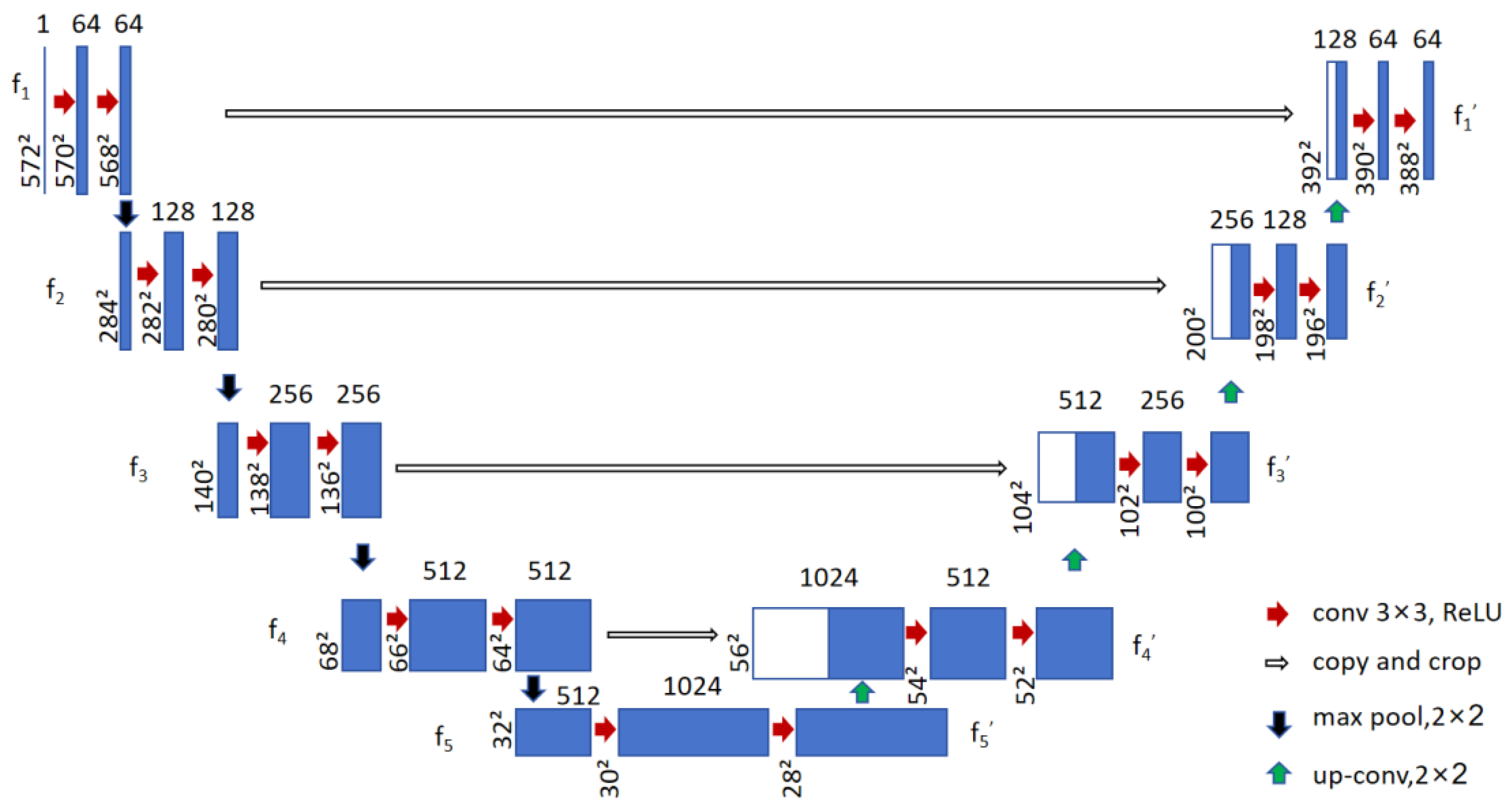
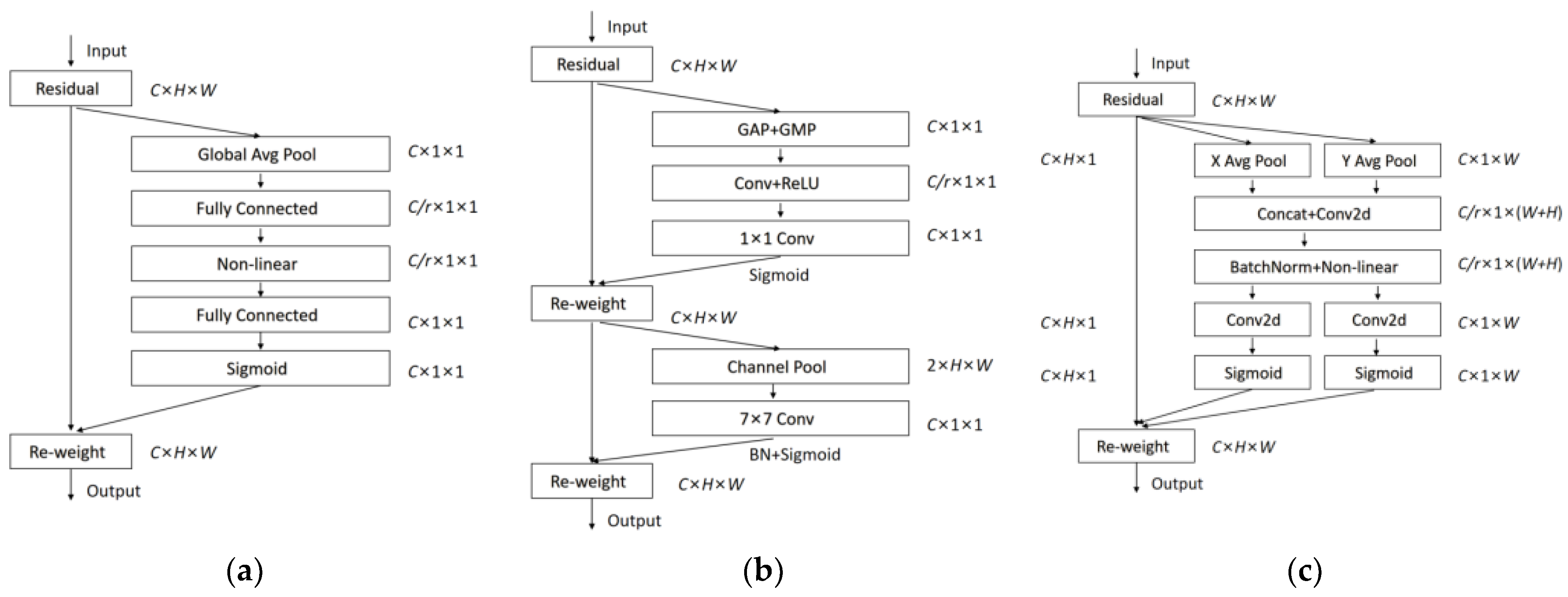
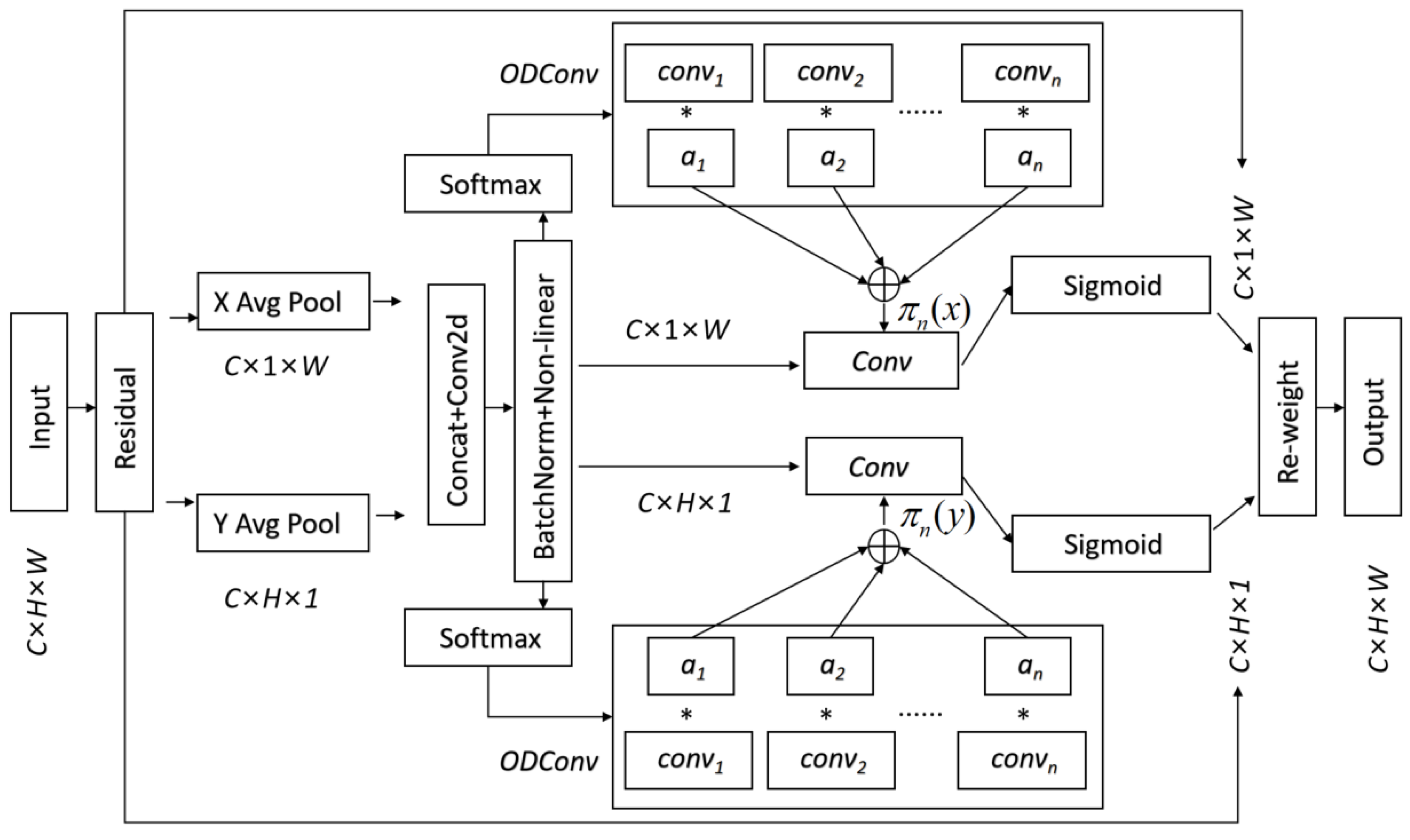
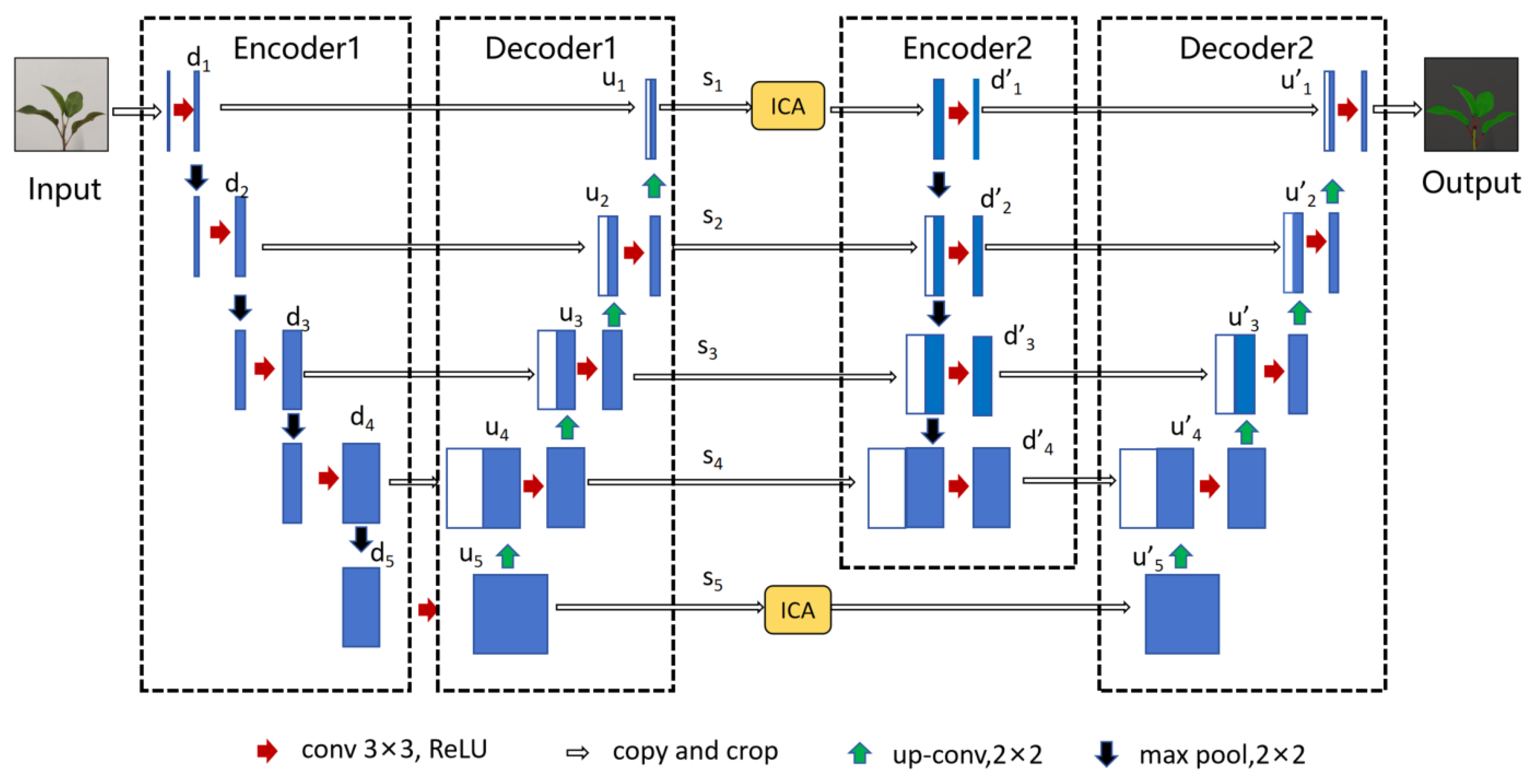
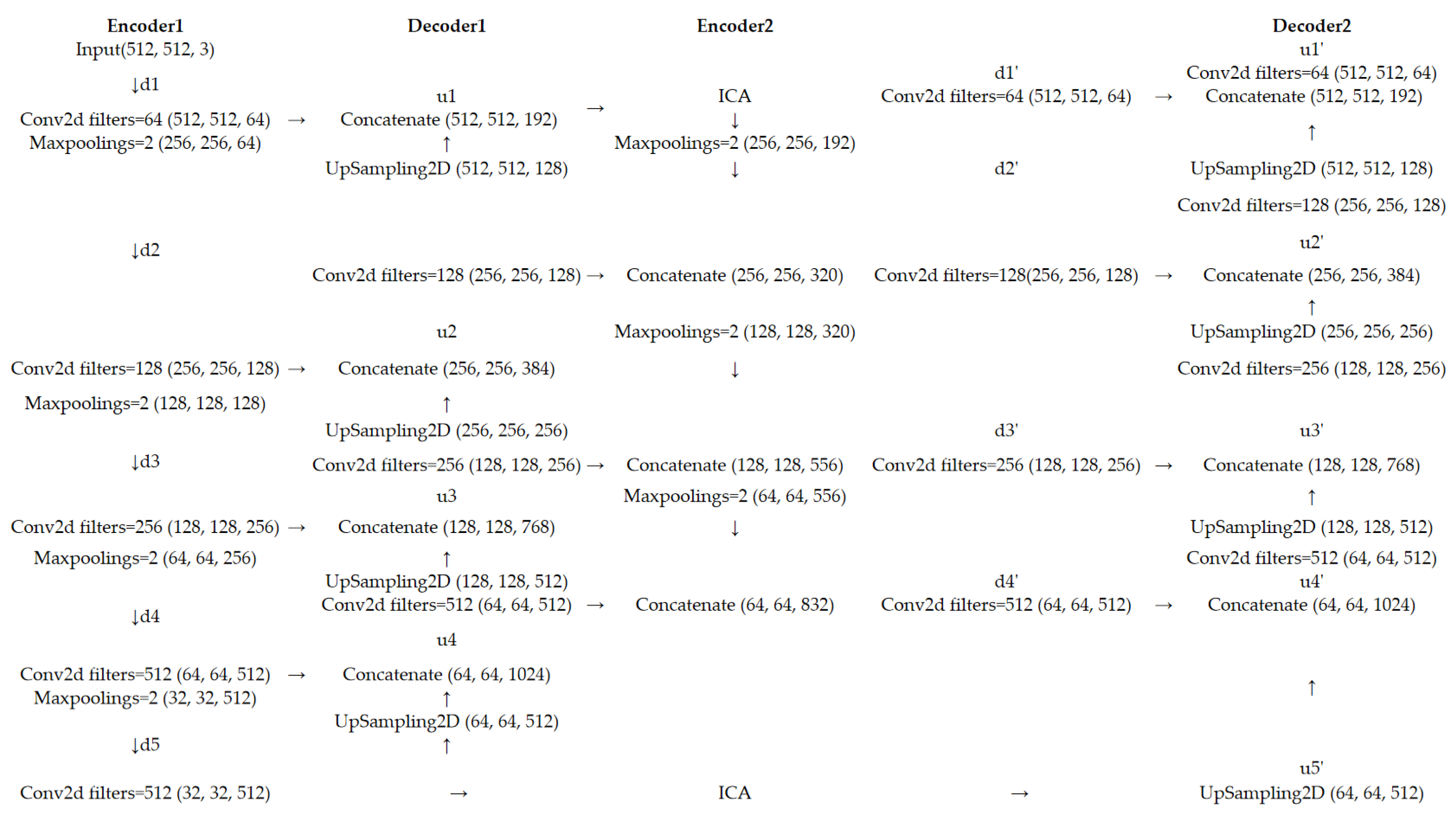

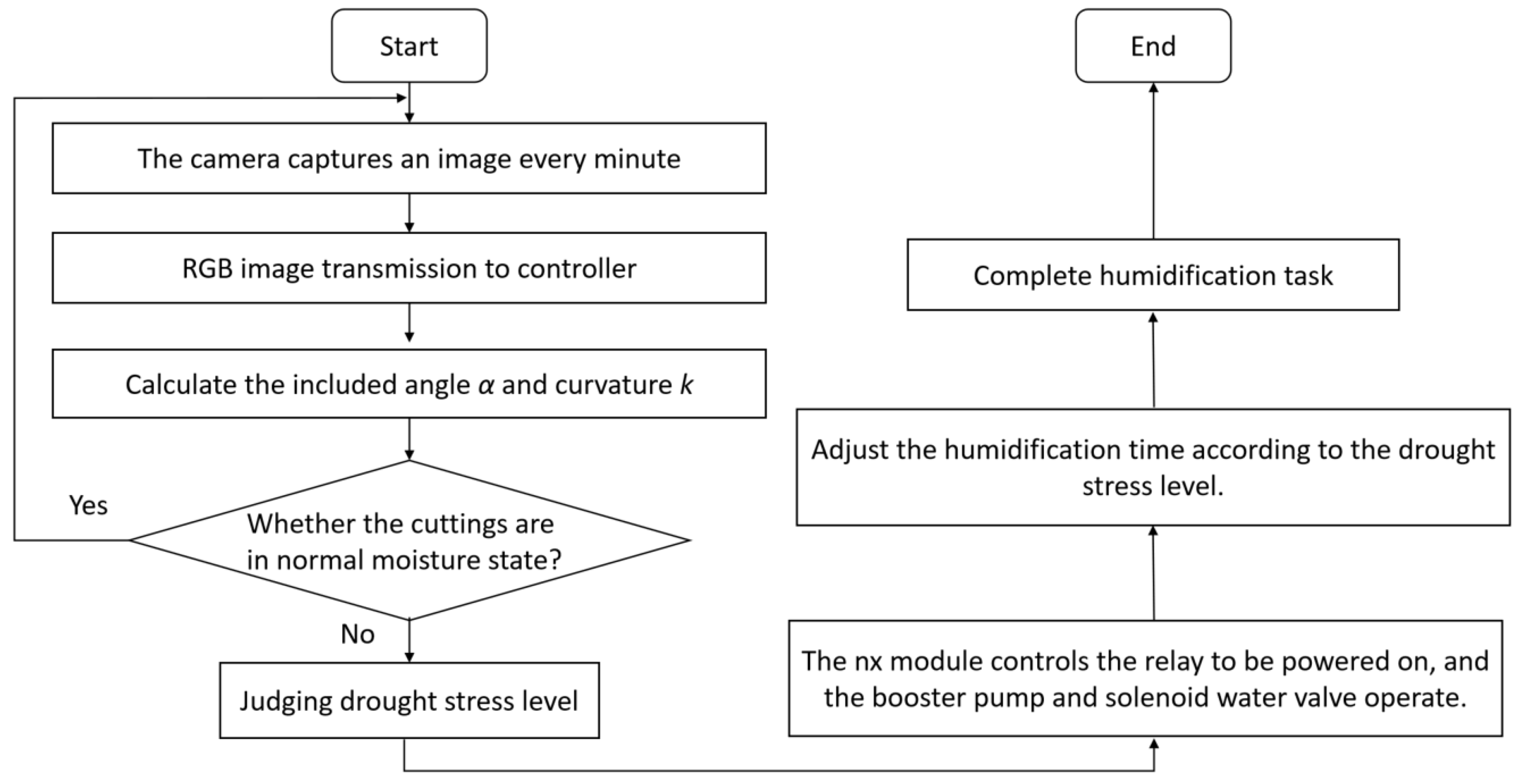

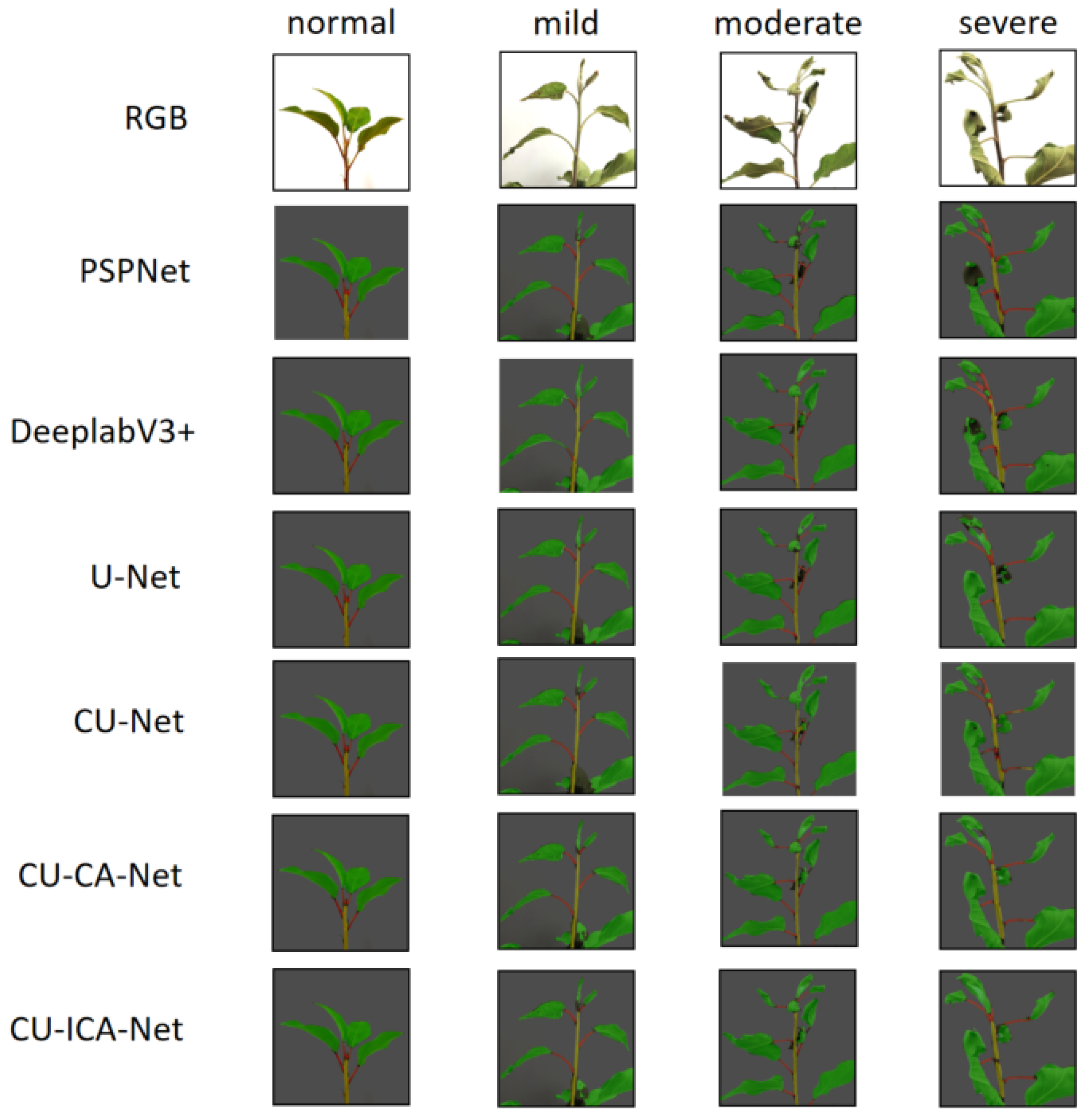
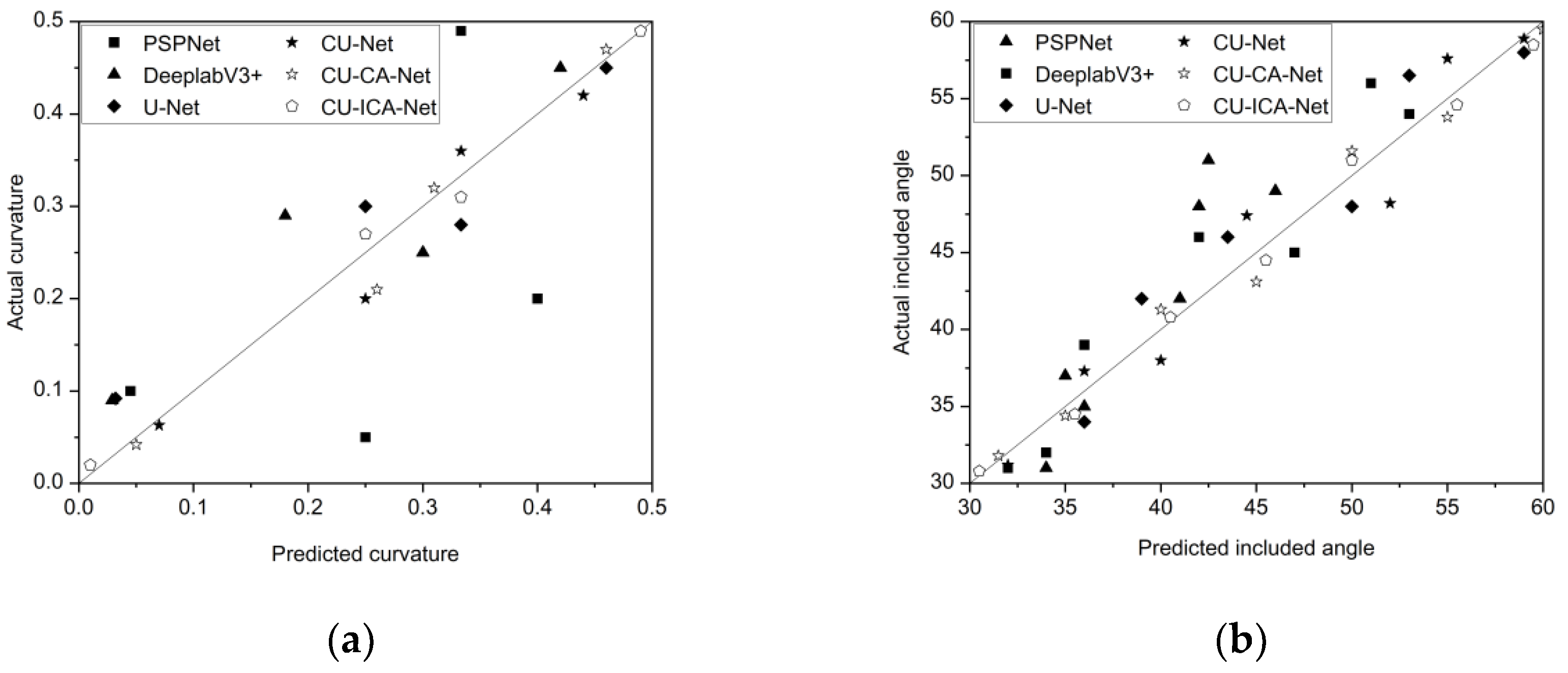
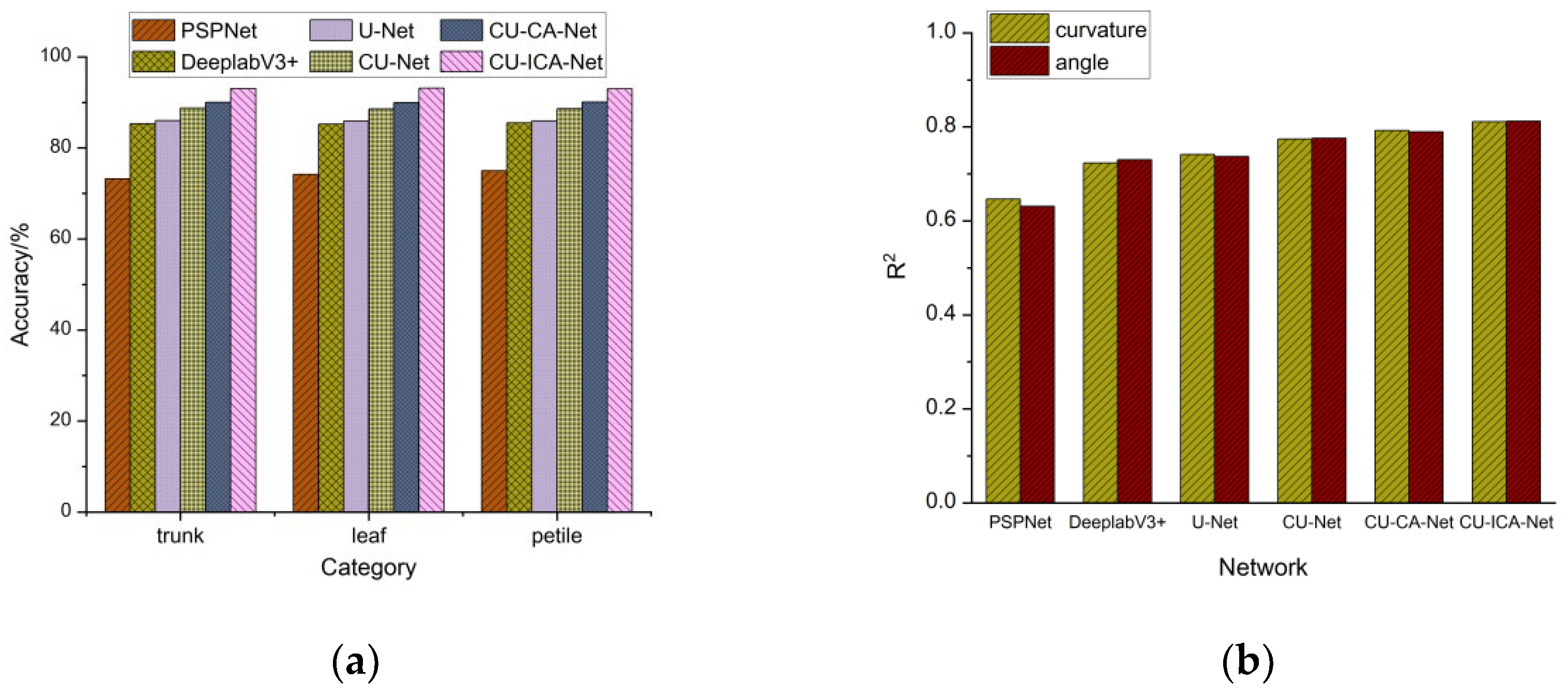
| Network Name | Backbone Structure | Core Modules | Architectural Features |
|---|---|---|---|
| U-Net | U-shaped structure | Basic convolution module, pooling module, upsampling module | Encoder–decoder structure that fuses multi-level features via skip connections. |
| CU-Net | Cascaded structure | Basic convolution module, pooling module, upsampling module | Encoder–decoder structure that fuses multi-level features via skip connections. |
| CU-CA-Net | Cascaded structure | Adding CA attention module based on CU-Net. | Encoder–decoder structure that fuses multi-level features via skip connections. CA modules are embedded in the deepest and shallowest skip connection layers. |
| CU-ICA-Net | Cascaded structure | Adding ICA attention module based on CU-Net. | Encoder–decoder structure that fuses multi-level features via skip connections. ICA modules are embedded in the deepest and shallowest skip connection layers. |
| Predicted Category\Actual Category | Stem (A) | Leaf (B) | Petiole (C) |
|---|---|---|---|
| Stem (A) | TPA | FPA | FCA |
| Leaf (B) | FAB | TPB | FCB |
| Petiole (C) | FAC | FPB | TPC |
| Indicator | Normal Group | Mild Group | Mode Group | Severe Group |
|---|---|---|---|---|
| s2 for petiole curvature k | s2 < 0.01 | s2 ≈ 0.02~0.05 | s2 ≈ 0.05~0.1 | s2 < 0.08 |
| s2 for petiole angle α | s2 < 5° 2 | s2 ≈ 10° 2 | s2 ≈ 20° 2 | s2 < 15° 2 |
| Model | Number of Images | Average Detection Time (ms) | FPS | MIoU | Average Accuracy of k (%) | Average Accuracy of α (%) |
|---|---|---|---|---|---|---|
| PSPNet | 400 | 21.46 | 18.64 | 0.621 | 43.22 | 41.32 |
| DeeplabV3+ | 400 | 11.38 | 35.14 | 0.804 | 87.43 | 85.66 |
| U-Net | 400 | 10.88 | 36.77 | 0.832 | 88.17 | 87.31 |
| CU-Net | 400 | 11.09 | 36.07 | 0.846 | 89.65 | 88.28 |
| CU-CA-Net | 400 | 11.93 | 33.53 | 0.883 | 90.35 | 89.15 |
| CU-ICA-Net | 400 | 12.54 | 31.90 | 0.913 | 93.18 | 92.79 |
| Group | Duration of Single Humidification (s) | Opening Times of Humidification System | Times of Drought Stress Grade | Total Operation Time (s) | Water Consumption (L) | ||
|---|---|---|---|---|---|---|---|
| Mild | Moderate | Severe | |||||
| Labor group | 3 | 14 | 0 | 14 | 0 | 42 | 7.21 |
| CU-ICA-Net | - | 23 | 10 | 13 | 0 | 36 | 6.18 |
Disclaimer/Publisher’s Note: The statements, opinions and data contained in all publications are solely those of the individual author(s) and contributor(s) and not of MDPI and/or the editor(s). MDPI and/or the editor(s) disclaim responsibility for any injury to people or property resulting from any ideas, methods, instructions or products referred to in the content. |
© 2025 by the authors. Licensee MDPI, Basel, Switzerland. This article is an open access article distributed under the terms and conditions of the Creative Commons Attribution (CC BY) license (https://creativecommons.org/licenses/by/4.0/).
Share and Cite
Wang, X.; Wang, P.; Li, J.; Liu, H.; Yang, X. Drought Stress Grading Model for Apple Rootstock Softwood Cuttings Based on the CU-ICA-Net. Agronomy 2025, 15, 1508. https://doi.org/10.3390/agronomy15071508
Wang X, Wang P, Li J, Liu H, Yang X. Drought Stress Grading Model for Apple Rootstock Softwood Cuttings Based on the CU-ICA-Net. Agronomy. 2025; 15(7):1508. https://doi.org/10.3390/agronomy15071508
Chicago/Turabian StyleWang, Xu, Pengfei Wang, Jianping Li, Hongjie Liu, and Xin Yang. 2025. "Drought Stress Grading Model for Apple Rootstock Softwood Cuttings Based on the CU-ICA-Net" Agronomy 15, no. 7: 1508. https://doi.org/10.3390/agronomy15071508
APA StyleWang, X., Wang, P., Li, J., Liu, H., & Yang, X. (2025). Drought Stress Grading Model for Apple Rootstock Softwood Cuttings Based on the CU-ICA-Net. Agronomy, 15(7), 1508. https://doi.org/10.3390/agronomy15071508






